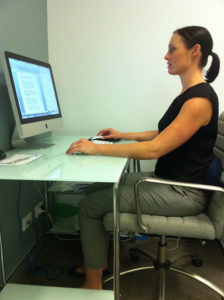The goal of ergonomics is to make work more comfortable and to improve both health and productivity. Many ergonomic problems can be fixed by rearranging, adjusting or modifying existing furniture and tools, so don’t be in too much of a rush to go out and purchase the next great ergonomic “THING”.
We know that sitting for long periods can have negative consequences for our health, and that regular breaks along with standing for part of your day can help to prevent and relieve aches and pains when they occur. However, often sitting cannot be avoided, at which times it is important to ensure that your office chair is set-up to provide optimal support for your back.
Steps for setting up your workspace:
Adjust the chair height so that your elbows are at desktop level (roll your shoulders back and relax them first).
Sit fully back into your chair, adjust the seat back for good lower back support, use a lumbar roll if the back of the chair does not support your lower back.
If your chair seat has a tilt feature, set it so that you are comfortably supported.
If your feet don’t comfortably reach the floor or there is pressure on the backs of your legs, use a footrest.
Locate your monitor so the top third of the viewing area is at or below eye level. Use monitor stand if required. As long as you can clearly view the screen contents there is no specific distance that you need to be from the monitor.
With elbows at the desk level, ensure that your wrists are straight. Use wrist rest if required, and if you have armrests try to adjust them so they support your arms without beings too high or too low.
Position the mouse as close as is practical to the keyboard, so that both elbows are directly under the shoulders while working. If this is not possible you may need to consider purchasing a mini keyboard.
To reduce stress on the neck when working from paper documents, a document holder can be placed between the keyboard and monitor.
Always either put the phone on loudspeaker (depending on your office environment) or use a phone headset if you need to use the computer while talking on the phone, this will help avoid neck and shoulder strain.
Use your mouse pad or another soft surface to pad the edge of your desk. Avoid pressing your hands or forearms against any desk edge.
Adjust screen brightness and contrast for clear comfortable viewing, and clean the screen regularly. Also remember the 20-20-20 rule: look away from the monitor every 20 minutes to a distance of 20 metres for 20 seconds. This helps avoid eye strain.
Finally and very importantly remember to take breaks regularly preferably every 45 minutes to an hour for 1 or 2minutes. Go get a glass of water talk to a colleague etc.


